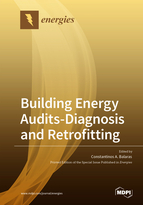Building Energy Audits-Diagnosis and Retrofitting
A special issue of Energies (ISSN 1996-1073). This special issue belongs to the section "G: Energy and Buildings".
Deadline for manuscript submissions: closed (30 June 2020) | Viewed by 43055
Special Issue Editor
Interests: high performing buildings; sustainable cities; EUI baselines & benchmarks; environmental impact of buildings; embodied energy; indoor environmental quality; solar heating & cooling; energy audits-diagnosis; building renovations
Special Issues, Collections and Topics in MDPI journals
Special Issue Information
Dear colleagues,
Building energy audits are used to systematically collect and analyze relevant data for obtaining adequate knowledge on the energy use profile of a building or group of buildings (e.g., regional or national buildings stocks), in order to identify, quantify, prioritize, or rank cost-effective energy conservation and efficiency measures. They are also employed for the sustainability assessment of buildings, neighborhoods, cities, and regions. The findings can be used to diagnose existing problems, quantify and report on the opportunities and measures that improve the overall building performance and the environmental quality and well-being of occupants and residents, lower the operating costs for existing buildings, or verify that new projects are constructed, equipped, and operated according to higher energy and sustainability standards that meet the owner’s expectations and intent.
Topics of interest for this Special Issue include, but are not limited to:
- methods and tools for building energy audits, surveys, diagnosis, inspections, assessment;
- non-destructive testing, measuring, monitoring, and analysis of data;
- energy efficiency and conservation measures;
- calculation, measurement, and verification of energy savings;
- model calibration, gap analysis;
- energy performance contracts and certificates, risk analysis, and assessment;
- benchmarking energy use intensity and breakdown for end uses,
- financial assessment, cost analysis;
- case studies and lessons learned from the field;
- conservation and efficiency measures for retrofitting building stocks;
- monitoring and assessing sustainable development at building or urban scale.
Dr. Constantinos A. Balaras
Guest Editor
Manuscript Submission Information
Manuscripts should be submitted online at www.mdpi.com by registering and logging in to this website. Once you are registered, click here to go to the submission form. Manuscripts can be submitted until the deadline. All submissions that pass pre-check are peer-reviewed. Accepted papers will be published continuously in the journal (as soon as accepted) and will be listed together on the special issue website. Research articles, review articles as well as short communications are invited. For planned papers, a title and short abstract (about 100 words) can be sent to the Editorial Office for announcement on this website.
Submitted manuscripts should not have been published previously, nor be under consideration for publication elsewhere (except conference proceedings papers). All manuscripts are thoroughly refereed through a single-blind peer-review process. A guide for authors and other relevant information for submission of manuscripts is available on the Instructions for Authors page. Energies is an international peer-reviewed open access semimonthly journal published by MDPI.
Please visit the Instructions for Authors page before submitting a manuscript. The Article Processing Charge (APC) for publication in this open access journal is 2600 CHF (Swiss Francs). Submitted papers should be well formatted and use good English. Authors may use MDPI's English editing service prior to publication or during author revisions.
Keywords
- building & HVAC energy audits, survey, diagnosis, inspections
- energy performance
- energy efficiency and conservation measures
- implementation and verification
- energy use and gap analysis, benchmarking
- building stock modeling
- building, urban, and city sustainability assessment






